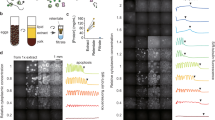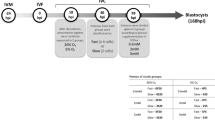Abstract
THE addition to culture medium of phosphorylated compounds which preferentially bind Mg2+ substantially reduces the rate of DNA synthesis and metabolism of chick embryo fibroblasts (CEF)1. This has suggested that Mg2+ might be an intracellular regulator for coordinate control of the rate of cell growth and metabolism in animal cells1. We report here that the omission of Mg2+ from the culture medium can have considerable effects on cell growth and macromolecular synthesis by CEF if the Mg2+ is withdrawn at the time cells are being stimulated to grow by means of an increase in the concentration of serum in the medium. These observations are discussed in terms of a model in which the intracellular concentration of free Mg2+ coordinately regulates the rate of metabolism and cell growth through its role as an essential cofactor for transphosphorylation reactions.
This is a preview of subscription content, access via your institution
Access options
Subscribe to this journal
Receive 51 print issues and online access
$199.00 per year
only $3.90 per issue
Buy this article
- Purchase on Springer Link
- Instant access to full article PDF
Prices may be subject to local taxes which are calculated during checkout
Similar content being viewed by others
References
Rubin, H., Proc. natn. Acad. Sci. U.S.A., 72, 3551–3555 (1975).
Rein, A., and Rubin, H., Expl cell Res., 49, 666–678 (1968).
Gurney, T., Proc. natn. Acad. Sci. U.S.A., 62, 906–911 (1969).
Rubin, H., and Koide, T., J. Cell Biol., 56, 777–786 (1973).
Rubin, H., and Steiner, R., J. Cell. Physiol., 85, 261–270 (1975).
Yang, D., and Morton, H. J., In Vitro, 6, Abstract 54 (1970).
Eagle, H., Archs Biochem. Biophys., 61, 356–366 (1956).
Rubin, H., and Koide, T., J. Cell. Physiol., 86, 47–58 (1975).
Rubin, H., Proc. natn. Acad. Sci. U.S.A., 69, 712–716 (1972).
Balk, S. D., Whitfield, J. F., Youdale, T., and Braun, A. C., Proc. natn. Acad. Sci. U.S.A., 70, 675–679 (1973).
Fodge, D., and Rubin, H., Nature new Biol., 246, 181–183 (1973).
Singh, V., Singh, M., August, J., and Horecker, B., Proc. natn. Acad. Sci. U.S.A., 71, 4129–4132 (1974).
Sanui, H., J. Cell. Physiol., 75, 361–368 (1970).
Rose, I., Proc. natn. Acad. Sci. U.S.A., 6, 1079–1086 (1968).
Rubin, H., Proc. natn. Acad. Sci. U.S.A., 73, 168–172 (1976).
Author information
Authors and Affiliations
Rights and permissions
About this article
Cite this article
KAMINE, J., RUBIN, H. Magnesium required for serum-stimulation of growth in cultures of chick embryo fibroblasts. Nature 263, 143–145 (1976). https://doi.org/10.1038/263143a0
Received:
Accepted:
Issue Date:
DOI: https://doi.org/10.1038/263143a0
This article is cited by
Comments
By submitting a comment you agree to abide by our Terms and Community Guidelines. If you find something abusive or that does not comply with our terms or guidelines please flag it as inappropriate.



